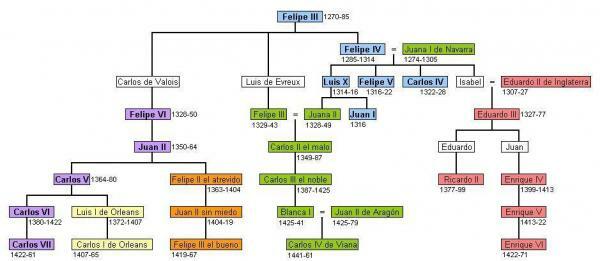100 years war: countries that clashed

In this lesson from a PROFESSOR we are going to discover one of the longest conflicts in the history of Europe, the so-called 100 years war, which was an armed conflict between the kingdoms of France and England, Both countries were the ones that faced each other and this confrontation lasted exactly 116 years between 1337 and 1453. More than a constant struggle, it was actually a series of military and diplomatic clashes characterized by stages of war campaigns alternated by truces.
Keep reading this lesson and you will discover the countries that fought in the 100 Years War as well as other important aspects of this battle such as the causes that originated it and its consequences.
In this summary of the Hundred Years War We are going to see what were the main causes for which both countries faced each other.
- On one side England claimed the French crown For dynastic reasons and by dominating part of the French territory, they managed to improve their economy, since they produced their famous wines and salt from Guyena (an old province in the south-west of France).
- France, for its part, sought to recover lands occupied by the English (Normandy and Aquitaine) and end feudalism.
Thus, the countries that fought in the 100 Years War were England and France, a battle that began for these reasons and that, finally, lasted for a whole century.
Then inside the summary of the 100 Years War, We will see how this is divided into several stages, and they are the following:
First stage (1337 - 1360)
Period that covered the reign of Edward III ofEngland, claiming the kingdom of France. Terrible events and bloody victorious fights on the part of the English took place until the signing of the Peace of Bretigny in the year 1360, when Eduardo III accepted the properties of Calais and Aquitaine, renouncing the crown of France.
Second stage (1360 -1380)
A stage of triumph for the French, when the king Carlos V got the territories ceded in the treaty of the Peace of Bretigny which returned to belong to the French crown.
Third stage(1380-1429)
There were new confrontations but this time, England triumphed. The war was against the crown of Charles VI of France ordered by Henry V of England, who after his triumph forced him to sign the Treaty of Troyes in 1420. The French monarch accepted as heir to the English king, who had married his daughter Catherine, a fact for which several truces were obtained.
Fourth stage (1429-1453)
A period in which the presence of Joan of Arc. The English took possession of the North and entered Paris, through the intervention of Joan of Arc at the head of the battle and the French knights ended the conflict. She was captured by the English allies, handed over and burned at the stake.
The crowns of England and France, the countries that clashed, were left in the power of Henry VI of England in 1431, being the successor before the death of the kings who signed the Treaty of Troyes, after which there was a five-year truce. The end of the 100 Years War, came when Charles VIII of France in 1450 he annihilated the English army in Fromigny, but it was not until 1453 when he recovered France except Calais.
In this other lesson from a TEACHER we will reveal to you a summary biography of Joan of Arc.

Image: Wikimedia Commons
We end this 100 Years War summary with the consequences of said conflict and it is that at the end of the war France ended up exhausted after a such prolonged confrontation and the results were observed in the political, economic, military and Social. Here are some of the most important consequences of this battle:
- This armed struggle weakened the nobility of France that, before the death of the feudal lords, the lands came to belong to the King.
- In the political sphere, the monarchical system was consolidated in both countries, leaving behind the forms of medieval government and promoting the appearance of absolutist monarchies.
- In economic terms, the devastation of the French territory was almost total, with agriculture paralyzing.
The different stages that this war went through led to consider these years in history as the most dramatic and devastating. Finally, say that the 100-year war influenced the development of the Modern State.



